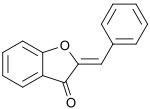


| |
| Names | |
|---|---|
| Preferred IUPAC name
2-Benzylidene-1-benzofuran-3(2H)-one | |
| Other names
2-Benzylidenebenzofuran-3(2H)-one | |
| Identifiers | |
| |
3D model (JSmol) |
|
| ChemSpider |
|
PubChem CID |
|
CompTox Dashboard (EPA) |
|
| |
| |
| Properties | |
| C15H10O2 | |
| Molar mass | 222.243 g·mol−1 |
Except where otherwise noted, data are given for materials in their standard state (at 25 °C [77 °F], 100 kPa). | |
Anaurone is a heterocyclic chemical compound, which is a type of flavonoid.[1] There are two isomers of the molecule, with (E)- and (Z)-configurations. The molecule contains a benzofuran element associated with a benzylidene linked in position 2. In aurone, a chalcone-like group is closed into a 5-membered ring instead of the 6-membered ring more typical of flavonoids.

Aurone forms the core for a family of derivatives which are known collectively as aurones. Aurones are plant flavonoids that provide yellow color to the flowers of some popular ornamental plants, such as snapdragon and cosmos.[2] Aurones including 4'-chloro-2-hydroxyaurone (C15H11O3Cl) and 4'-chloroaurone (C15H9O2Cl) can also be found in the brown alga Spatoglossum variabile.[3]
Most aurones are in a (Z)-configuration, which is the more stable configuration according to Austin Model 1 computation.[3] But there are also some in the (E)-configurations such as (E)-3'-O-β-d-glucopyranosyl-4,5,6,4'-tetrahydroxy-7,2'-dimethoxyaurone, found in Gomphrena agrestis.[4]
Aurones are biosynthesized starting from coumaryl-CoA.[5] Aureusidin synthase catalyzes the creation of aurones from chalcones through hydroxylation and oxidative cyclization.[2]
Some aurone derivatives possess antifungal properties[6] and analogy with flavonoids suggests that aurones could have other biological properties.[7]
|
Types of flavonoids
| |||||||||||||||||||||||||||||||||||||||||
|---|---|---|---|---|---|---|---|---|---|---|---|---|---|---|---|---|---|---|---|---|---|---|---|---|---|---|---|---|---|---|---|---|---|---|---|---|---|---|---|---|---|
| Flavonoids |
| ||||||||||||||||||||||||||||||||||||||||
|
Aurones and their glycosides
| |
|---|---|
| Aurones |
|
| Glycosides |
|